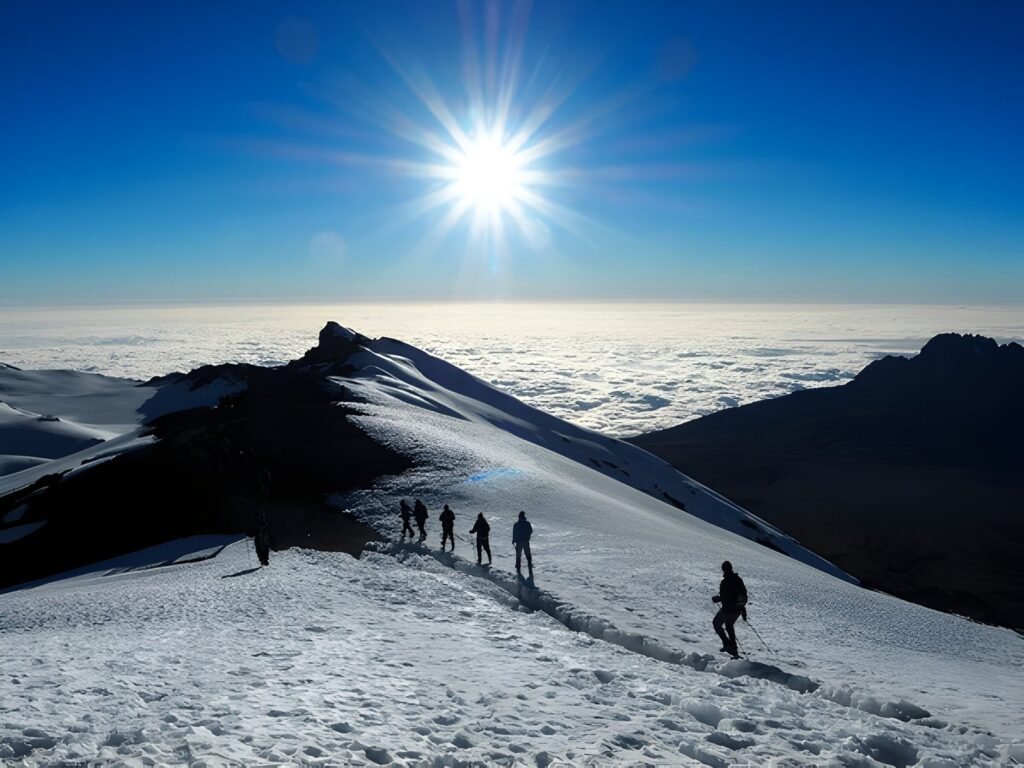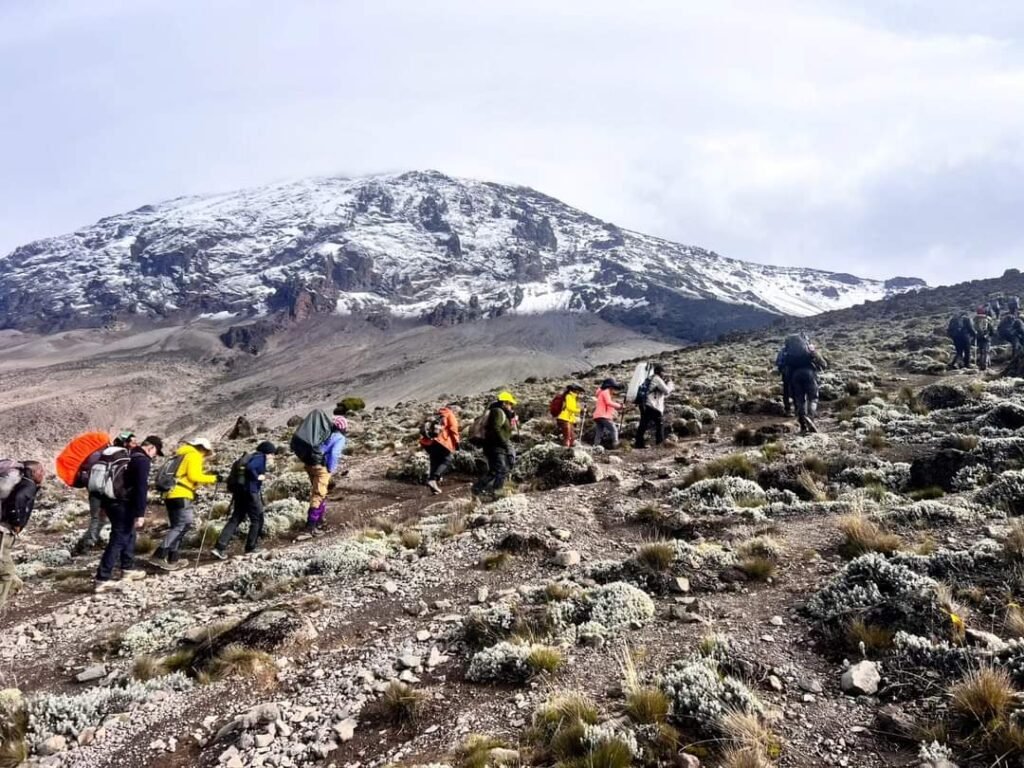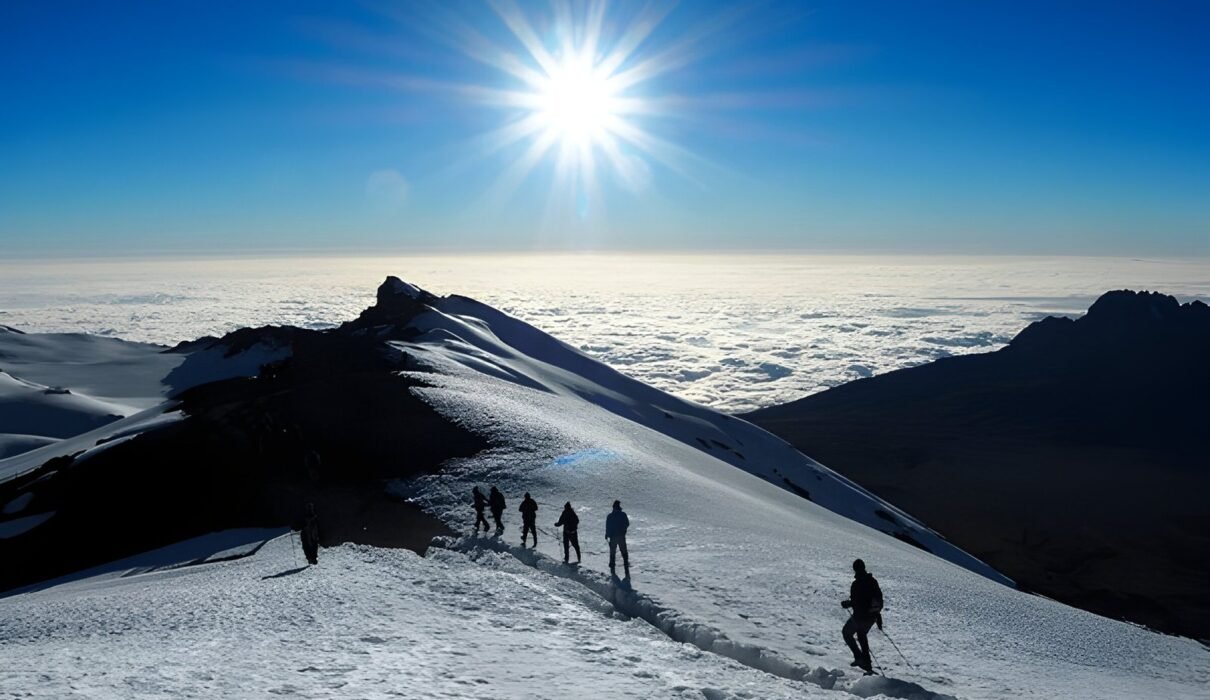Kilimanjaro Group Climb 2025: Routes and Options for an Epic Adventure / Mount Kilimanjaro, the tallest mountain in Africa and one of the most iconic climbs in the world, attracts adventurers from every corner of the globe. For those seeking camaraderie, professional guidance, and shared experiences, a group climb in 2025 offers the perfect opportunity to conquer this majestic peak. Whether you’re an experienced hiker or a first-time climber, joining a Kilimanjaro group climb ensures you’ll be well-supported on your journey to the summit.
In this comprehensive guide, we’ll break down the best routes for a Kilimanjaro group climb in 2025, the benefits of climbing in a group, and how to prepare for this unforgettable adventure.

Kilimanjaro Group Climb 2025: Routes and Options for an Epic Adventure / Why Join a Kilimanjaro Group Climb?
1. Shared Experience and Motivation
Climbing Kilimanjaro is a challenging yet incredibly rewarding endeavor. Joining a group allows you to share the journey with like-minded individuals, making the experience more enjoyable and motivating. The camaraderie and teamwork developed along the way help push you through the tough moments, especially as you ascend toward the summit.
2. Cost Efficiency
Group climbs are typically more affordable than solo expeditions because expenses for guides, porters, and logistics are shared among participants. Many tour operators offer all-inclusive group climb packages, making budgeting easier and ensuring everything from park fees to accommodation is covered.
3. Professional Guidance
Climbing Kilimanjaro requires no technical mountaineering skills, but having experienced guides is crucial. Reputable tour operators provide professional guides who monitor your health, manage the pace, and ensure proper acclimatization to reduce the risk of altitude sickness. Joining a group climb means you’ll have access to this expertise while enjoying a well-coordinated adventure.
Kilimanjaro Group Climb 2025: Routes and Options for an Epic Adventure / Best Routes for a Kilimanjaro Group Climb in 2025
Choosing the right route is essential for your Kilimanjaro success. Each route offers a unique experience in terms of scenery, difficulty, and acclimatization opportunities. Below are the most popular routes for group climbs in 2025:
1. Machame Route (Whiskey Route)
- Duration: 6-7 days
- Difficulty: Challenging
- Popularity: Very high
- Accommodation: Camping
The Machame Route is often referred to as the “Whiskey Route” because it’s more difficult than the Marangu Route but offers a more scenic and diverse experience. It’s one of the most popular routes for group climbs due to its higher success rate (around 85%) and stunning landscapes, which include dense rainforests, dramatic ridgelines, and expansive vistas.
- Pros: High success rate, varied scenery, great acclimatization profile.
- Cons: Steeper and more physically demanding.
2. Marangu Route (Coca-Cola Route)
- Duration: 5-6 days
- Difficulty: Moderate
- Popularity: High
- Accommodation: Huts
The Marangu Route is the only Kilimanjaro route that offers hut accommodations rather than camping, making it appealing to climbers who prefer a bit more comfort. It’s known as the “Coca-Cola Route” because it’s seen as the easiest and most direct path to the summit. However, the shorter duration means less acclimatization time, leading to lower summit success rates (around 60%).
- Pros: Hut accommodation, shorter duration, well-established trail.
- Cons: Lower success rate due to quick ascent, more crowded.
3. Lemosho Route
- Duration: 7-8 days
- Difficulty: Challenging
- Popularity: Moderate
- Accommodation: Camping
The Lemosho Route is considered one of the most scenic routes to the summit, offering breathtaking views of Kilimanjaro’s varied ecosystems, from lush rainforests to alpine deserts. It’s less crowded than Machame and Marangu, making it a great option for those looking to enjoy a quieter trek. The longer duration allows for excellent acclimatization, resulting in higher success rates (around 90%).
- Pros: Beautiful scenery, quieter trail, excellent for acclimatization.
- Cons: Longer duration means higher costs.
4. Rongai Route
- Duration: 6-7 days
- Difficulty: Moderate
- Popularity: Low to moderate
- Accommodation: Camping
The Rongai Route is the only route that approaches Kilimanjaro from the north, near the Kenyan border. It’s known for being less crowded and more remote, offering a unique and quieter experience. Although it’s a bit drier than other routes, it’s still very scenic, and the gradual ascent makes it a good choice for those concerned about altitude sickness.
- Pros: Less crowded, gradual ascent, dry conditions.
- Cons: Fewer acclimatization opportunities compared to Lemosho and Machame.
5. Northern Circuit Route
- Duration: 9-10 days
- Difficulty: Moderate to challenging
- Popularity: Low
- Accommodation: Camping
For those looking for the ultimate Kilimanjaro experience, the Northern Circuit Route offers the longest and most scenic trek around the mountain. With plenty of time for acclimatization and stunning panoramic views, it’s an excellent choice for serious trekkers aiming to maximize their chances of reaching the summit (success rates are among the highest at 95%).
- Pros: Best acclimatization profile, fewer crowds, diverse scenery.
- Cons: Longest duration and higher cost.
Kilimanjaro Group Climb 2025: Routes and Options for an Epic Adventure / What to Expect on a 2025 Kilimanjaro Group Climb
1. Daily Schedule
Most days on Kilimanjaro begin early, with breakfast served around sunrise. You’ll spend 4-7 hours trekking each day, depending on the route and the day’s terrain. Afternoons are often spent resting and acclimatizing at higher altitudes, while evenings are reserved for dinner and relaxation.
On summit night, you’ll start your ascent around midnight to reach the summit at sunrise—a challenging yet exhilarating experience.
2. Acclimatization
Altitude sickness is one of the biggest challenges on Kilimanjaro. The key to a successful climb is proper acclimatization, which is why longer routes like Machame, Lemosho, and Northern Circuit have higher success rates. Tour operators use the “climb high, sleep low” method to help your body adjust to the altitude.
3. Safety and Support
Safety is a top priority on Kilimanjaro group climbs. Guides carry oxygen tanks and first aid kits, and they monitor climbers for signs of altitude sickness. If necessary, they’ll recommend descending to a lower altitude for safety.
Porters will carry your main gear, so you’ll only need to carry a daypack with essentials like water, snacks, and extra layers.
Kilimanjaro Group Climb 2025: Routes and Options for an Epic Adventure / Cost of a Kilimanjaro Group Climb in 2025
The cost of a Kilimanjaro group climb in 2025 varies depending on the route, tour operator, and the services included. Here’s a general breakdown of what you can expect:
- Group Climb Packages: $1000 – $5,000 per person, including park fees, guides, porters, meals, and camping or hut accommodations.
- Additional Expenses:
- Flights to Tanzania: Costs vary by location but average between $800 and $1,500 round trip.
- Travel Insurance: Essential for covering any medical emergencies or evacuation.
- Gear Rental: If you don’t have your own gear, items like hiking boots, sleeping bags, and jackets can be rented locally.
- Tipping: It’s customary to tip guides and porters, usually around $250-300 per climber.
Kilimanjaro Group Climb 2025: Routes and Options for an Epic Adventure / How to Prepare for Your Kilimanjaro Group Climb
1. Physical Training
Climbing Kilimanjaro requires a good level of fitness, especially on longer, more challenging routes. Start training several months in advance with a mix of cardio, strength training, and endurance hikes.
- Cardio exercises like running, cycling, or swimming help build stamina.
- Strength training for your legs and core will prepare you for long days of trekking.
- Hiking with a weighted backpack simulates the conditions you’ll face on the mountain.
2. Mental Preparation
In addition to physical preparation, you’ll need to be mentally tough. Summit night can be particularly challenging due to the cold, darkness, and steep terrain. Stay positive, and remember that reaching the summit is a once-in-a-lifetime achievement.
3. Gear Checklist
Packing the right gear is essential for your comfort and safety on Kilimanjaro. Here’s a basic packing list:
- Sturdy, waterproof hiking boots
- Thermal clothing and base layers
- Waterproof jacket and pants
- Hat, gloves, and sunglasses
- Headlamp for summit night
- Trekking poles
- Water bottles or hydration bladder
- First aid kit with altitude sickness medication

Kilimanjaro Group Climb 2025: Routes and Options for an Epic Adventure / Frequently Asked Questions (FAQs)
1. How long does it take to climb Kilimanjaro?
Most group climbs take between 6 and 10 days, depending on the route. Longer routes like Lemosho and Northern Circuit provide better acclimatization and increase your chances of reaching the summit.
2. What is the best time of year to climb Kilimanjaro?
The best times to climb are during the dry seasons from January to March and June to October. These months offer more stable weather and better trail conditions.
3. Do I need technical climbing experience?
No, Kilimanjaro is a non-technical trek, meaning you don’t need climbing skills. However, you do need to be physically fit and prepared for long days of hiking at high altitudes.
4. Can I join a group climb if I’m traveling solo?
Yes! Many solo travelers join group climbs, which is a great way to meet new people and share the experience with fellow adventurers.
5. What is the success rate for reaching the summit?
Success rates vary by route, but with proper acclimatization and preparation, many climbers successfully reach the summit. Longer routes like Lemosho and Northern Circuit have success rates of 85-95%.
Kilimanjaro Group Climb 2025: Routes and Options for an Epic Adventure / Conclusion
If you’re ready to conquer Mount Kilimanjaro in 2025, joining a group climb is an excellent way to embark on this life-changing adventure. With the right route, proper preparation, and a supportive group, you’ll be well-equipped to tackle Africa’s highest peak and create memories that will last a lifetime.

